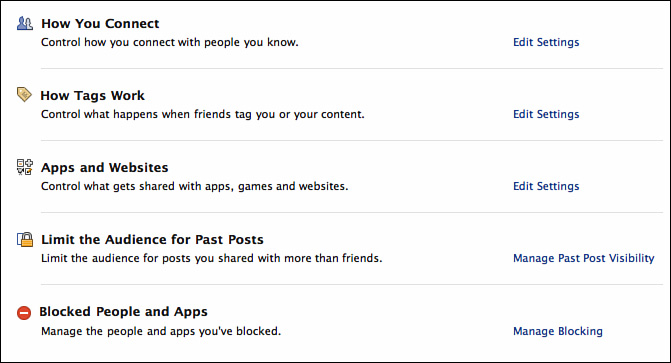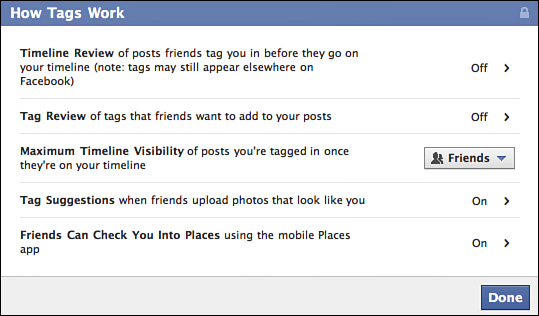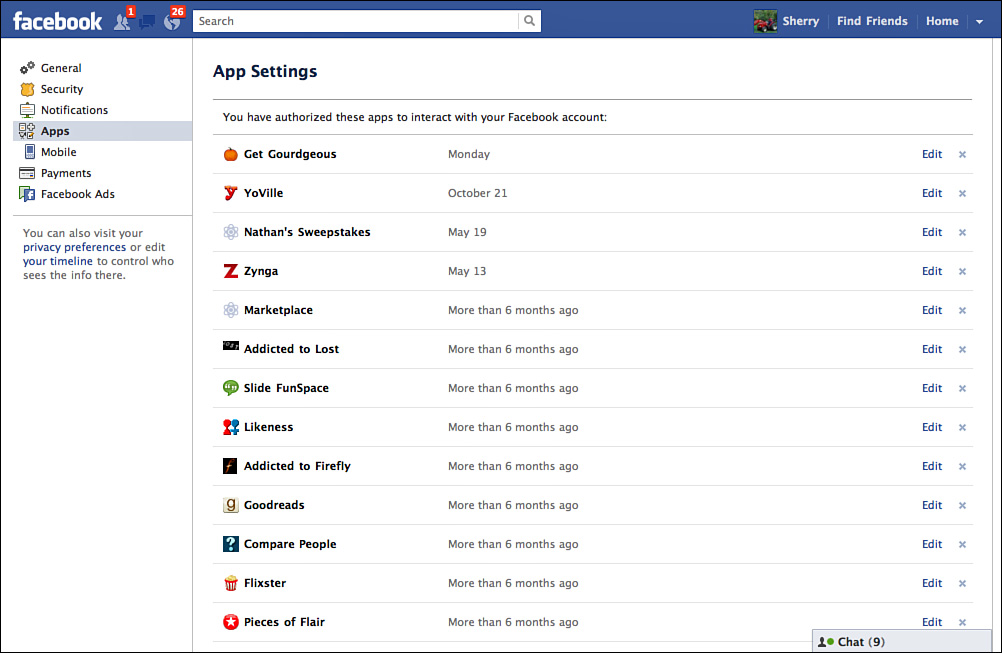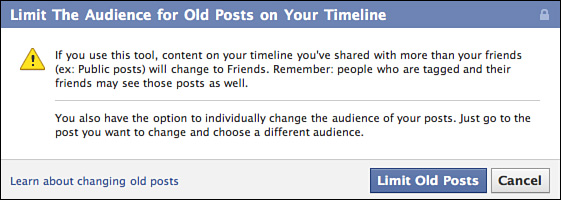Lesson 7. Guarding Your Privacy
In this lesson, you learn how to protect yourself on Facebook by logging in more smartly, changing your privacy settings, and blocking apps and people as needed.
Understanding Privacy and Security Settings on Facebook
Privacy and security are the number-one concerns on the Internet, and are particularly relevant in the world of social networking. Identity theft is a daily threat, and spammers lurk behind many websites, trying to nab your email address. Guarding yourself online is more important than ever. Along with these dangers, a social networking site such as Facebook also throws in the risks of humiliation, embarrassment, and criticism if you end up posting information you’re not supposed to or revealing far too much information to the wrong people. So, how do you begin to protect yourself and still network freely?
The reality is anything you post on Facebook has the potential to be publicly available. This includes your picture and your profile information, such as political views, relationship status, and so on. Facebook does do all it can to protect your personal information, but things happen, hackers can attack, and so on. You may think that only people you allow to be your friends on Facebook can view your info, but that’s not the case. There are ways of finding someone’s profile on Facebook. Potential employers, law enforcement, teachers, and anyone else determined to do so can find a way to see your profile. If your privacy settings are lax, even a simple search engine can access your profile.
Companies and third-party developers that partner with Facebook can also access your information when allowed. Per Facebook’s policy, advertisers who sell products on Facebook can access your information, so safeguarding the info is also up to those companies. Hundreds of third-party applications are available on Facebook, and to make use of them, you must allow them access to your information. In doing so, the potential exists for unscrupulous third-party developers to misuse your data. Because you’ve allowed them access to the info by adding the application to your account, Facebook can’t do much about it.
The bottom line is that taking steps to protect yourself is up to you. Thankfully, you can pursue some strategies to help battle privacy and security breaches, or even stop them from occurring.
Pursuing Protection Strategies
Despite the possibilities for exposure and risk, don’t let the fear of privacy and security keep you from enjoying your Facebook experience. You can keep yourself relatively safe just by following a few simple practices:
• First and foremost, use common sense when participating in any online endeavor. If something seems risky, it probably is. If someone from your Facebook network emails you about a get-rich plan, you can be sure it’s a scam, so don’t take the bait.
• Never give out personal or sensitive information in a public forum. For example, don’t post your cell phone number so that it can be read in everyone’s Facebook news feed. You’re just asking for trouble.
• If Facebook users stalk you or harass you, block their access to your profile and report them to Facebook.
• Although the profile information form (see Lesson 2, “Setting Up a Facebook Account”) has places for it, you’re not required to place personal information of any kind in your profile. For example, if you don’t feel comfortable adding your home or work address and phone numbers, don’t do it. You can share this type of information through a private email on a “need-to-know” basis.
• If you’re worried about spammers, consider using a free email address from a site such as Google or Yahoo! for your Facebook account. This can help you protect your main email address from unwanted exposure.
• Always be leery of links to sites outside of Facebook that come to you via friends. Make sure the site is legitimate before giving out information. Phishing, the practice of tricking people into revealing sensitive data, is widespread, but you can usually spot these threats by their poor grammar and typos, so keep your eyes peeled.
• Even though Facebook advocates honesty, people aren’t always what or who they seem to be online. Be skeptical, cautious, and vigilant when it comes to meeting new people online.
• When it comes to deciding whether to post something, just ask yourself whether your mom or your employer would be comfortable with it. For example, do you really want your mom or your boss to see a picture of you at that wild party last weekend? Better to err on the side of good judgment with regard to your personal information and pictures.
• Finally, make use of the controls Facebook offers to help you stay safe on the site. Why let useful privacy control settings go to waste?
The rest of this lesson shows practical steps you can take to protect your privacy and security on Facebook, which has revamped a lot of the security settings recently. Even if you’re already familiar with Facebook, you might want to peruse what’s changed to make sure that you’re well protected and current.
Caution
Be sure to safeguard other people’s info on Facebook, too. For example, refrain from forwarding email messages with the original senders’ addresses left in them.
Controlling Account Access
One of the best ways to control your Facebook account is to use some smart login practices. When you log in to your account from the top of the main Facebook page, shown in Figure 7.1, you have the option of checking the Keep me logged in check box. This feature tells Facebook to keep you logged in until you decide to log out. Although this might seem like a handy way to avoid typing in your ID and password each time you access your account, it’s actually a problem if you’re using Facebook on a shared computer. For example, if you’re using a computer at a public library, school, or workplace, other users access the computer after you. If you forget to log out, the next user at the computer can access your account. In other words, you’ve left the door to your information wide open.
Figure 7.1 Facebook’s login page has a check box to keep yourself signed in if you want.
Tip
Worried about a breach with your Facebook account? You can reset your Facebook password with just a few quick clicks. Good passwords always include a combination of letters, numbers, and symbols (if allowed). To reset a password, click the drop-down arrow in the navigation bar (the downward-pointing arrow icon next to the Home link) and click Account Settings to open the Account Settings page. Click the Edit link next to the Password option. Type your current password, type a new password, and retype the new password to confirm it. Click the Save Changes button to finish the procedure.
If you use Facebook only from a home computer, the option can be a timesaver. However, if your entire family uses the same computer, they can easily access your account and pose as you online—not that anything bad can come from that, right? Aside from the sarcasm, an unprotected home computer is also vulnerable to people who come in and out of your house, such as babysitters, repairmen, and friends.
To prevent unwanted access entirely, make sure the Keep me logged in check box is deselected when you log in to your account. Second, always log out of the site when you’ve finished by clicking the Account drop-down arrow on the navigation bar at the top of any Facebook page and then clicking the Log Out option. Do not just click the browser’s Close button—you must genuinely log out to end the Facebook connection.
Customizing Your Privacy Settings
You can control your privacy on Facebook in several ways. Just about all the privacy settings let you specify whether you want to post the information for all to see, share it just among your friends, or customize it so only selected friend lists or individuals see it. Although the Facebook designers keep tweaking the controls, which may result in different screens than those shown here, the basic premise is still the same—these settings enable users to choose exactly how they want their information made available to others.
Log in to Facebook and click the Account menu drop-down arrow at the top of any Facebook page, and then click the Privacy Settings option from the pop-up menu that appears (see Figure 7.2).
Figure 7.2 Access privacy settings through the Account menu.
Facebook displays the Privacy Settings page, similar to Figure 7.3. The page features links for controlling how you connect with people, how tags are applied, how applications and websites interact with your info, how others view your old posts, and how to make a block list for blocking unwanted users and apps.
Figure 7.3 The Privacy Settings page is the place to go to set privacy controls.
The first thing to set is a default privacy setting, which applies to any postings that don’t already have their own individual privacy controls. For example, if you use a Facebook app to post items from your Blackberry device, the default privacy setting you specify dictates how the information is shared on Facebook. You can choose Public, Friends, or Custom. Most users are happy with the Friends setting.
If you scroll down the page a bit, you’ll find the rest of the privacy settings, as shown in Figure 7.4. You’ll learn more about these settings in the remainder of this lesson.
Figure 7.4 Scroll down the Privacy Settings page to see more features.
Controlling How You Connect
Use the How You Connect settings to control who can look up your profile page information (also known as the timeline), send you friend requests and messages, post on your timeline, and view other timeline posts. When you click the Edit Settings link next to the How You Connect category (refer to Figure 7.4), Facebook opens the How You Connect box, as shown in Figure 7.5.
Figure 7.5 Use these settings to control how people interact with you on Facebook.
Off to the right side of each setting is an “audience selector,” which is basically a drop-down menu (Figure 7.5 shows one displayed) that lets you choose who is allowed to interact with you. Simply click the selector and click an option. Depending on the privacy setting, the options may include all or several of the following:
• Everyone—The most open level of privacy, allowing anyone on Facebook to view the information.
• Friends of Friends—Only immediate friends and friends of friends can view the information.
• Friends—Only people you’ve friended on Facebook can view the information.
• Only Me—You’re the only one who can use the feature.
• Custom—Enables you to customize exactly which friends can or cannot view the information.
If you have created lists of people on Facebook, such as grouping all your family members into a list, the lists may also appear as an option for selection.
After you’ve made your selection(s), click the Done button to return to the Privacy Settings page.
Tip
If you’re worried about people seeing your picture on your Facebook profile, consider using an image other than an actual photo of you. For example, you might use a picture related to your hobbies or interests instead. Visit Lesson 2 to learn more about adding and changing a profile picture.
Controlling How Tags Work
Facebook tags are used to link a person, page, or place to a status update, photo, or video. Basically, a tag is an identifier. Anytime you tag a person, Facebook lets her know about it, and the posted item is visible to everyone in that person’s timeline. For example, let’s say you went to a birthday party and took some photos of the guest of honor and the other partygoers. You can add a tag to the photo on Facebook that lets your friend know she’s in the photo and helps other friends know about the photo, too.
New to Facebook, the How Tags Work privacy category gives you more control regarding how tags are handled. You can review tags before they’re posted to your or your friend’s timelines, control who is allowed to see the tags after they appear in your timeline, identify potential photos of you for tagging, and let friends tag you in places you visit. To view the tag settings, click the Edit Settings link next to the How Tags Work category on the Privacy Settings page (refer to Figure 7.4). Facebook opens the How Tags Work box, as shown in Figure 7.6. You can use this box to turn features on or off or specify who views your tags.
Figure 7.6 Use these settings to control how tags behave.
After you finish setting tag options, click Done to return to the Privacy Settings page.
Controlling Apps and Websites
Applications and games are add-on programs that work with Facebook. They come in a wide variety of types and functions, from the serious to the silly. Some applications, or apps for short, are part of your Facebook account by default, such as the Notes and Photos applications. We cover applications in greater detail in Lesson 13, “Adding Applications,” but as they relate to privacy, let’s talk about how to control them a bit here so you’re better informed when more apps start crossing your path later.
Here’s a fact: Most of the applications and games you add in Facebook access your profile information. You typically can’t use an application unless you allow this. Sounds logical, yes? But did you know that applications your friends allow access to can also access information about you just because you’re their friend? Sneaky, eh? You can de-authorize this access using the Apps, Games and Websites page as part of the Facebook privacy settings. You can also control what types of information are shared. To find your way to application privacy settings, click the Edit Settings link located next to the heading Apps and Websites on the Privacy Settings page (refer to Figure 7.4). The Apps, Games and Websites page, shown in Figure 7.7, offers several options:
• Apps you use—Lists recent applications, games, and websites you’re using with Facebook. You can remove apps or turn them off using the options listed here, or click the Edit Settings button to view a complete list.
• How people bring your info to apps they use—Control what information is shared from your profile when your friends use Facebook-enhanced applications and related websites.
• Instant personalization—Turn on or off personalization shared with Facebook’s partner sites, such as Docs.com or Yelp, when your friends use them.
• Public search—Enable or disable public search controls regarding your timeline. Although technically this isn’t related to apps and games, it is sort of related to website searches, so the option appears on this page.
Figure 7.7 The Apps, Games and Websites page lets you control what information applications and partner websites can access.
To control individual applications themselves, you must visit the App Settings page, shown in Figure 7.8. To find your way to this page, click the Edit Settings button next to the Apps You Use category (refer to Figure 7.7).
Figure 7.8 The App Settings page keeps a running list of your Facebook applications.
From the list of applications, you can edit the settings of each application, read more about the application itself, or remove it entirely:
• Click the Edit link to display more information about the app or fine-tune how it works with your information.
• To remove an application entirely, click the X button at the far-right end of the application listing and click Remove. You’ll be prompted when the process is over; click Okay.
To learn more about applications and how they work in Facebook, see Lesson 13.
Limiting Past Posts
Another new option to the privacy settings is the ability to limit who sees your older posts. As you’ve already learned in Lesson 4, “Navigating Your Timeline,” you can quickly change the audience for any particular post on your timeline using the inline controls, but what if you want to reset all of your past postings at once? Ideally, the Limit Past Posts feature on the Privacy Settings page is handy if you’ve previously had all your postings set to Public, which means everyone can see them, and you want to reset all the past postings to be viewed only by your friends. Keep in mind that if you enact this tool, you can’t undo it. Anyone who added comments to the older postings will lose access to those comments. To activate the feature, click the Manage Past Post Visibility link next to the Limit the Audience for Past Posts category found on the Privacy Settings page. This opens a dialog box, shown in Figure 7.9. Click the Limit Old Posts button to start the procedure.
Figure 7.9 Old posts too public? No problem; limit them retroactively using this privacy setting tool.
Blocking People and Apps
The final option to cover under Facebook’s privacy controls is how to block other Facebook members and apps.
This particular feature is used to restrict someone from bothering you or accessing you on Facebook. When you block users, they can no longer see your profile information or interact with you through Facebook features. This also means you can no longer see them on Facebook. Blocking them only knocks them out of contacting you in Facebook. Outside of Facebook is another matter.
From the Privacy Settings page (refer to Figure 7.4), click the Manage Blocking link next to the Blocked People and Apps category. This opens the Manage Blocking page, as shown in Figure 7.10.
Figure 7.10 Use the Block users area to block other Facebook members.
To block someone, just type his or her name in the Name box and press Enter (Return) or click the Block button. This opens the Block People dialog box. Simply identify the correct person you’re blocking, click the Block button next to their name, and the deed is done. The blocked user’s name is added to the Restricted list. You can add more people to the list, or even block them based on their email address instead.
You can also use the Manage Blocking page to block application invites. For example, if your friend is constantly inviting you to play FarmVille or Mafia Wars, you can stop all the application invites from that friend, including FarmVille and whatever other apps the friend is freely sharing with you. Just type your friend’s name in the Block invites from field located under the Block app invites area of the page.
If you’re tired of responding to certain event invitations, you can block them as well. Under the Block event invites area of the page, you can type the friend’s name and turn off future event invitations from him.
Reporting Abuse
Facebook tries to maintain a safe environment, but as in the real world, the online world is often fraught with illegal, offensive, and inappropriate material and conduct. Nudity, pornography, harassment, hate speech, and unwelcome contact are against Facebook’s rules. If you spot something along these lines, you can report it to Facebook. To contact them directly, you can email [email protected], and they’ll look in to the problem. In addition to this route, you can find Report links scattered throughout the Facebook pages. You can click a link to report a problem. For example, if you encounter a pornographic picture in someone’s photo album, you can click the Report This Photo link.
You can check out Facebook’s Security page for more help with questionable material and conduct and how to find help. To access the page, click the Help link at the bottom of any Facebook page to open the Help Center, and then click the Report Abuse or Policy Violations link to view related links. You can also click the Account menu drop-down arrow at the top of the Facebook page and click Help to find your way to the security info.
Tip
Anytime you want to refresh your knowledge of Facebook’s terms of service, click the Terms link at the bottom of any Facebook page. This opens a page with information, links to privacy settings, and so on.
Summary
In this lesson, you learned all about Facebook’s privacy settings and how to keep your data safe while using the website. In the next lesson, you learn more about communicating through Facebook.










